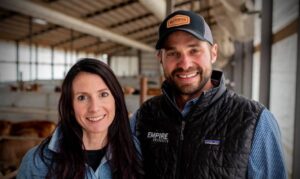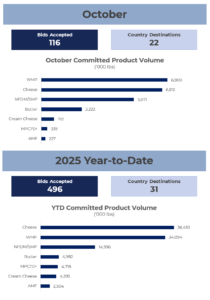 By Megan and Tim Schrupp, 2025 Chairs for the National Young Cooperators Program
By Megan and Tim Schrupp, 2025 Chairs for the National Young Cooperators Program
Across America, a new generation of dairy farmers are stepping into leadership roles, bringing innovation, passion, and a fresh perspective to the industry. Driven by a deep devotion to the dairy industry, these emerging leaders are redefining traditional farming with cutting-edge technology and sustainable practices, and are capitalizing on opportunities that foster connection, communication and collaboration within their communities — showing that the next generation of dairy farmers is ready to carry the tradition forward with energy and innovation. Their commitment not only strengthens the agricultural backbone, but also inspires a renewed confidence in rural America.
Supporting them in this endeavor is the National Young Cooperators (YC) Program. Established in 1950 and managed by the National Milk Producers Federation (NMPF), the YC Program has dedicated 75 years to training and leadership development for beginning dairy farmers, helping them become effective managers and influential leaders while enhancing the resilience and sustainability of their farms. The program offers a comprehensive suite of educational resources, tools, and support through both in-person and virtual events. It also builds a vibrant national network of peers, allowing young dairy farmers to share experiences, address challenges, and collaborate on solutions. Through this connected community, farmers receive valuable support and guidance as they grow in their roles and contribute to the future of the dairy industry.
This past year, we have been fortunate to have served as the chairpersons of the Advisory Board for the YC Program. Our dairy, NexGen Dairy, is a fourth-generation dairy farm and member-owner of First District Association in central Minnesota. Through our involvement in the YC Program, we have witnessed firsthand the bright future of the dairy industry, meeting numerous young dairy farmers from across the country.
While change and challenges are constant, we feel more than ever that our generation is faced with the requirement for an ever-expanding skill set that goes beyond traditional dairy practices. However, young farmers are rising to the challenge and are not only mastering cow and forage management, genetics, and business operations, but also excelling in employee leadership, advanced technology, and market economics. Many young dairy farmers also actively engage in understanding milk pricing, sustainability, and regulatory changes, ensuring their farms thrive in a competitive environment. They are embracing collaboration and ongoing learning, building strong networks with peers and industry leaders, and creating a supportive community that empowers them to succeed and shape the future of dairy farming with resilience and optimism.
Engaging with fellow young dairymen and women through the YC Program, we have observed the determination, talent, and sense of community that defines this new generation of dairy leaders. Witnessing other dairy farmers’ commitment to innovation, sustainability, and regulatory affairs has highlighted for us the promising path forward for our industry as a whole. We, as young farmers, are not only honoring the traditions that built American dairy, but also boldly reimagining its future. With continued investment from groups such as NMPF, focusing on leadership, innovation, and collaboration, the future of dairy farming rests in capable hands — ensuring our industry will continue to nourish and connect communities for generations to come.
This column originally appeared in Hoard’s Dairyman Intel on Nov. 6, 2025.

 NMPF economics department, co-managed with the U.S. Dairy Export Council, in October welcomed its newest staffer Katriel Marks-Yant.
NMPF economics department, co-managed with the U.S. Dairy Export Council, in October welcomed its newest staffer Katriel Marks-Yant. 




